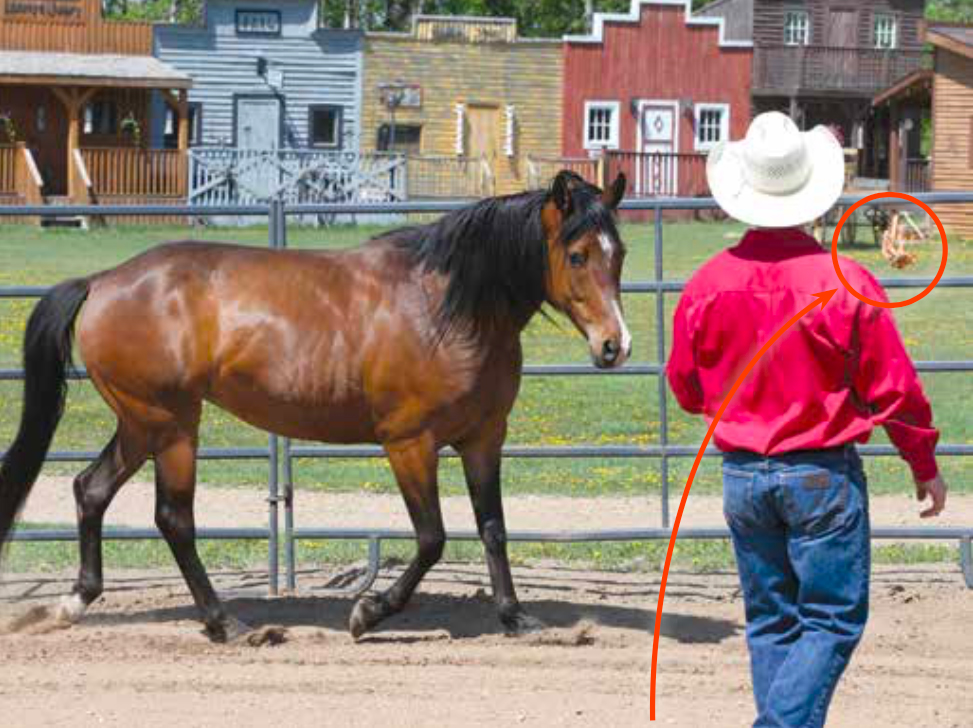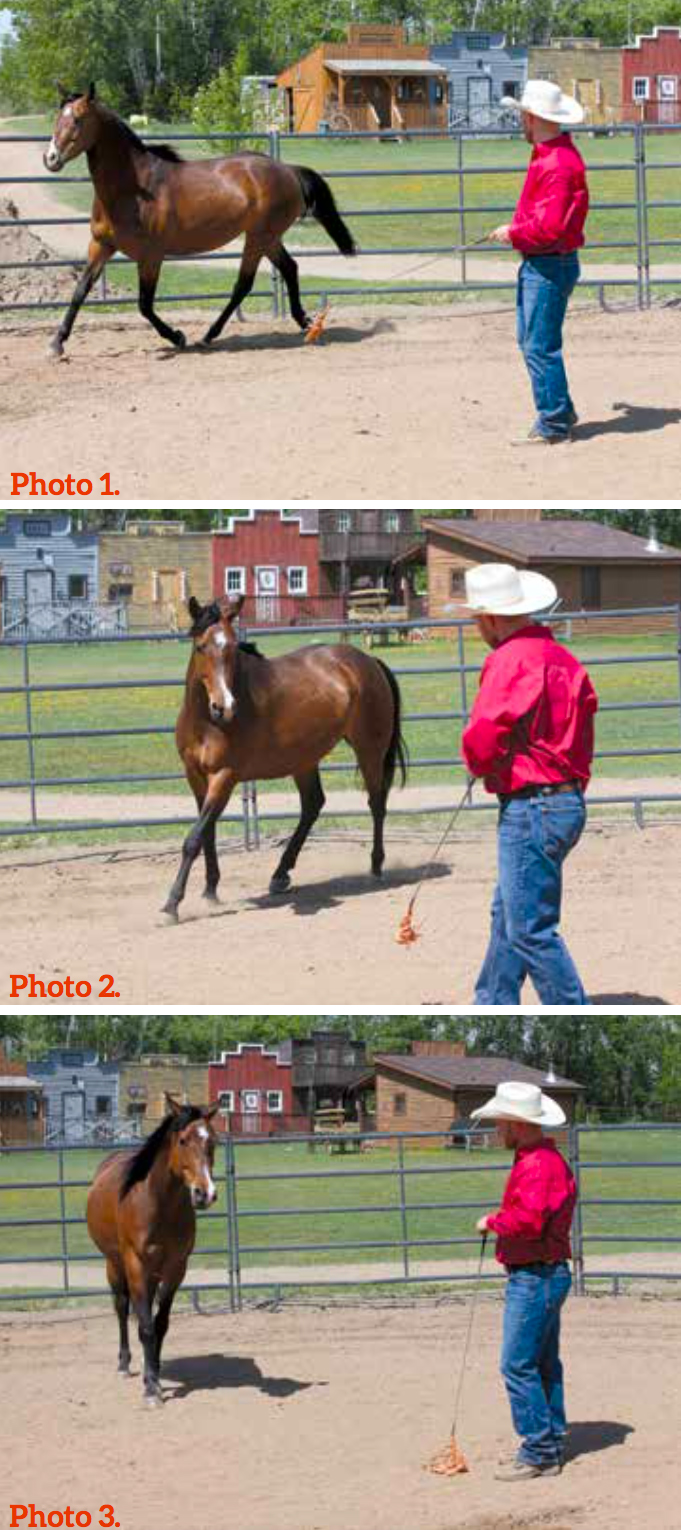In my last post, I talked a bit about the three Relational needs of Mind, Space, and Pressure, and how the round pen can help us to start meeting those needs:
“The first thing is to determine what your horse’s primary need is. Are they more of a “Pressure” horse, meaning they are sensitive and scared of pressure? Are they primarily a “Mental” type, strongly focused on their own thoughts, but not really scared? Are they mainly a “Spatial” horse who is mentally present, not fearful, and who may push into your space seeking spatial interaction? While all horses are a mix of the three types to varying degrees, figuring out their most prominent characteristic will give you an important advantage in the round pen, because once you know what is important to the horse, you will be able to meet that need and bring a level of peace.”
Today we’ll look at how you would use the round pen to start working with a Pressure horse.
When a horse is fearful of pressure, they will typically believe they need to run away from it. With such horses, it is extremely important to help the horse understand that he can actually control pressure by thinking “towards” you. In other words, if the horse shifts its focus to you, pressure goes away. This does three equally important things: a) it teaches the horse to think through pressure rather than simply react to it, b) it builds the horse’s self-confidence, making him less likely to feel the need to flee, and c) it shows him that being with you makes things much less scary. You can accomplish this with the following steps:

Here, Josh is using the light pressure of shaking a flag (circled) to cause just enough worry to draw the horse’s attention to the pressure, but not enough to cause the horse to feel the need to flee.
Step 1: Turn the horse loose in the round pen. Stand on one side of the pen near the rail. While keeping your energy calm and inviting, use a flag (my choice) or whatever aid you prefer to apply just enough pressure for the horse to begin to worry about it, but not enough to tip the horse over into real fear. I define worry as a state of concern in which the horse is still able to think, whereas fear produces a commitment to leaving and thinking has stopped.
If the horse needs to move its feet some while worried, that’s okay. Moving the feet is different than fleeing in panic. If you feel the horse is panicking due to your actions, you need to re-evaluate the situation and your use of pressure. You may be doing too much or may need a different aid in the beginning. With some extremely fearful horses, just being in the pen with them can be too much pressure for the horse to handle, in which case you may need to start the process with you outside the pen entirely.
If you feel the horse is still thinking while moving around, don’t stop your gentle pressure or you will teach the horse that the way to control pressure is to move away. If the horse circles around and comes towards you on the rail, just calmly hold your ground and define a bubble of space around you, using your energy to fill that space. You can also use your aid if necessary so that the horse has to change its thought enough to go around you. You are not looking to direct the horse at this point — you are simply owning your space.
Assuming you have created a mild degree of worry but not outright fear, the mind of the horse will usually bring its focus to the source of the worry — which in this case is your pressure. This is what you are looking for. If the horse even glances in your direction with one eye, stop your pressure immediately. The general idea is to help the horse understand that they can turn the pressure off, not by running away, but by staying and looking at you, which is the very opposite of their instinct. Achieving this gets a horse to start thinking through pressure, rather than automatically running from it.
Throughout this exercise, try to keep your energy the same — calm and centered. This is especially important when the horse struggles. When they do, don’t engage the horse’s worry by “getting smaller”, but also be sure you are not throwing energy around and causing stress. You are trying to create an environment in which the horse feels comfortable, as they are much more able to “hear you” and learn in that state of mind. There will, of course, be times when they are not at ease during the learning process, particularly at first, but maintaining a consistent, peaceful energy within yourself is a really important part of drawing them to a better place.

The bay’s tense posture (photo 1) shows that Josh’s flag has created a degree of worry, but when the pressure is neither too much nor too little, the horse is likely to want to focus on it (photo 2) instead of running from it. As soon as that happens, Josh drops his pressure (photo 3), which teaches the horse how to “control” the pressure.
Be aware, though, that keeping your energy the same does not mean you necessarily keep your pressure the same. You need to be ready to adjust your pressure as required, either up or down or applied in a different way. But when you do, the horse should feel the same calm, positive energy in you rather than a negative reaction from you — even when you are increasing your pressure. Remember that there are many ways to modulate pressure including intensity, proximity, and most importantly, the intention you have within you.
Step 2: Move to a new location in the pen, but stay away from the center. When you stand in the middle of the pen, you give the horse the opportunity to run circles around you, and you want to avoid that, as it does not encourage the kind of thinking and change you are looking for. So, pick a different spot close to the rail and repeat step one. Remember to remain calm and inviting in your energy, and that the slightest look towards you must be rewarded with an immediate cessation of pressure.
Step 3: Up to this point, you will have done nothing “directional” with your energy, neither asking the horse to come nor to move away. In this third step, you need to create a very clear intention that you want the horse to come towards you. To do this, you need to think “draw” in your mind and feel it in your body. You might make some subtle changes in your body language or how you are connecting to the space between you and the horse, but you don’t need to make any large, overt gestures. Some people find it helpful to think of becoming “softer” in their solar plexus, or to envision a gentle, inviting light moving into their body and pulling the horse with it.
When the horse’s thought connects with you and your energy is asking him to come, he may turn towards you and might begin walking towards you. If he doesn’t, you can try taking a step backwards or sideways to see if this will help draw him. If he still doesn’t come towards you at all, try stepping around in an arc towards his hindquarters, possibly even adding a hint of pressure and see what effect that has. If the horse moves away again, that is perfectly fine — just go back to the earlier steps and see if you can get a change.
In the beginning, don’t worry about trying to get a scared horse to come all the way to you or follow you. Just stay focused on applying a small amount of pressure when the horse’s mind has gone off into worry mode, and releasing it when they return to a calmer state and check in with you. Always be cautious to avoid doing too much and creating fear. Soon the horse will understand that they can control the pressure by staying with you mentally, and this is the beginning of a wonderful, connected relationship. Remember that you are aiming for a calming effect.
Please DO NOT try to “send” or move the scared type of horse away from you until they have become more confident about pressure and you have established a good degree of draw. You will then be able to start using pressure to ask them to move, and they will be in a position to learn how to respond to that request without worry. However, if sent too early, they will feel chased by you and will revert to fleeing. Try to always keep in mind that a Pressure horse is operating from a starting point of fear, so earning leadership with such a horse is about showing them that we will never give them reason to fear us, and that being with us is actually a really good, safe place.

Great reminder full of details and solutions.
This is great! Needed the reminder and helpful tips for this!
Well… what would you suggest with a horse with unknown history who shows defensive aggression towards pressure? If I pressure my gelding too much he charges me in an agessive manner. Semi rearing and pawing./ striking, charging with his ears pinned. It really doesn’t take too much like even waving a flag back and forth near my feet to get this response. Usually I will dop the flag and say No !and define my space… i thought the best way to work with him is to not pressure him at all… but to work on softening him with a soft feel. When I ride him he is fine…. i have had him for onlyb6 months now where I thought we trusted each other but maybe he was really abused in the past and has ptsd or something like it. I cant lunge him… he only turns to face me and so I basically don’t do any ground work with him other than leading him and asking him to soften.
I would take a bunch of time and do nothing with him really. Let him learn that you are not a threat and wait till he lets his guard down. Hang out with him and make sure you stay calm and relaxed. If there is abuse in his history he will be judging you through that lens. Make sure you don’t do anything that causes him to flip that switch. In time he will see you as something different, then you can begin having these conversations with him!
I have am orphaned colt. He’s 4 months old now and nipping and coming into our space. I can’t get any other horses at the moment. My horses passed last year. I work gently on a lead, groom, hoof cleaning every day. İt’s early but he’s alone so I want to connect with him. I need help before it gets worse as he’s just started this and don’t want to make any mistakes.